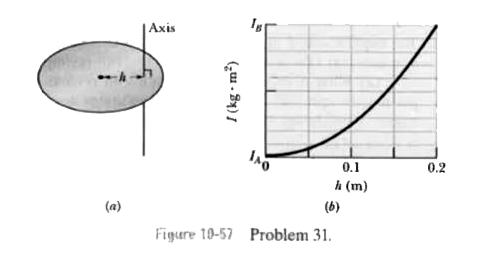Figure 10-57 a shows a disk that can rotate about an axis at a radial distance h from the center of the disk. Figure 10-57b gives the rotational inertia I of the disk about the axis as a function of that distance h, from the center out to the edge of the disk. The scale on the I axis is set by IA=0.050kg⋅m2andIB=0.150kg⋅m2. What is the mass of the disk?

2.5 kg
Topper's Solved these Questions
- RIGID BODY DYNAMICS - IBook:RESNICK AND HALLIDAYChapter:RIGID BODY DYNAMICS - IExercise:PRACTICE QUESTIONS (SINGLE CORRECT CHOICE TYPE)
Explore 43 Videos
- RIGID BODY DYNAMICS - IBook:RESNICK AND HALLIDAYChapter:RIGID BODY DYNAMICS - IExercise:PRACTICE QUESTIONS (MORE THAN ONE CORRECT CHOICE TYPE)
Explore 7 Videos
- RIGID BODY DYNAMICS - IBook:RESNICK AND HALLIDAYChapter:RIGID BODY DYNAMICS - IExercise:CHECKPOINT
Explore 18 Videos
- RELATIVITYBook:RESNICK AND HALLIDAYChapter:RELATIVITYExercise:PRACTICE QUESTIONS (Integer Type)
Explore 5 Videos
- RIGID BODY DYNAMICS-IIBook:RESNICK AND HALLIDAYChapter:RIGID BODY DYNAMICS-IIExercise:PRACTICE QUESTIONS (Integer Type)
Explore 2 Videos
Similar Questions
A 0.50 kg meter stick can rotate around an axis perpendicular to the stick. Find the difference in the stick's rotational inertia about the rotation axis if that axis is initially at the point marked "40cm" and then at the point marked "10cm".
View SolutionA uniform cylinder of radius 12 cm and mass 25 kg is mounted so as to rotate freely about a horizontal axis that is parallel to and 5.0 cm from the central longitudinal axis of the cylinder. (a) What is the rotational inertia of the cylinder about the axis of rotation? (b) If the cyliner is released from rest with its central longitudinal axis at the same height as the axis about which the cylinder rotates, what is the angular speed of the cylinder as it passes through its lowest position?
View Solution
Knowledge Check
A uniform disc of mass 2kg is rotated about an axis perpendicular to the plane of the disc . If radius of gyration is 50cm, then the M.I. of disc about same axis is
A0.25kgm2B0.5kgm2C2kgm2D1kgm2A uniform disk of mass 300kg is rotating freely about a vertical axis through its centre with constant angular velocity ω. A boy of mass 30kg starts from the centre and moves along a radius to the edge of the disk. The angular velocity of the disk now is
Aω06Bω05C4ω05D5ω06The moment of inertia of cylinder of radius a, mass M and height h about an axis parallel to the axis of the cylinder and distance b from its centre is :
A12M(a2+2b2)B12M(2a2+b2)C12M(a2+b2)D12M(a23+b212)
The rotational inertia of a disc about its axis is 0.70 kg m2. When a 2.0 kg mass is added to its rim, 0.40 m from the axis, the rotational inertia becomes
View SolutionCalculate the moment of inertia of a solid sphere of mass 10 kg and radius 0.5 m, rotating about an axis 0.2 m from the centre of the sphere .
View SolutionA body of moment of inertia 0.5kgm2 is rotating about a given axis at the rate 1rps. What is kinetic energy of rotation of the body about that axis ?
View SolutionAt what distance along the central perpendicular axis of a uniformly charged plastic disk of radius 0.600 m is the magnitude of the electric field equal to 25% of the magnitude of the field at the center of the surface of the disk ?
View SolutionA horizontal platform in the shape of a circular disk rotates on a frictionless bearing about a vertical axle through the centre of the disk. The platform has a mass of 150kg, a radius of 2.0m, and a rotational inertia of300kgm2 about the axis of rotation. A 60kg student walks slowly from the rim of the platform toward the centre. If the angular speed of the system is 1.5rad/s when the student starts at the rim, what is the angular speed when she is 0.50m from the centre ?
View Solution